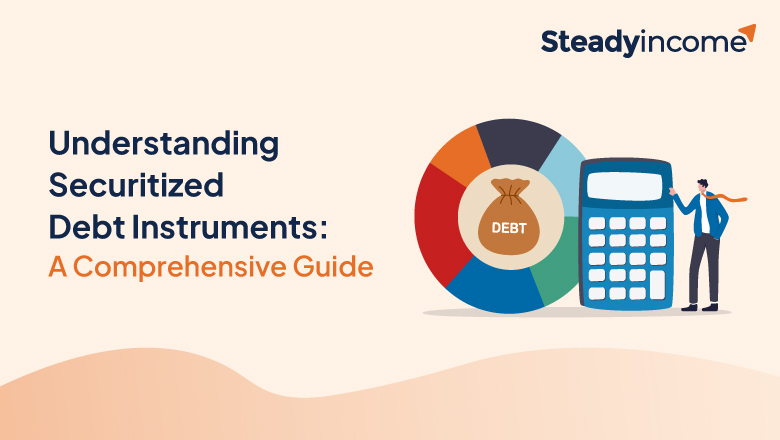Understanding Securitized Debt Instruments: A Comprehensive Guide

Introduction:
Securitized debt instruments are an essential part of modern finance, offering both borrowers and investors a structured way to access capital and manage risk. These instruments play a crucial role in the bond market, allowing companies, governments, and financial institutions to raise funds while giving investors a way to invest in debt with varying levels of risk and return.
This article will break down the key components of securitized debt instruments, their types, how they work, and the associated risks and benefits.
What Are Securitized Debt Instruments?
Securitized debt instruments refer to financial products backed by a pool of underlying assets, such as mortgages, loans, or receivables. These assets are packaged together, transformed into securities, and sold to investors. The cash flows generated by the underlying assets—such as mortgage payments or credit card receipts—are passed on to the investors in the form of interest payments and principal repayment.
The primary purpose of securitization is to transfer the risk associated with the underlying assets from the originator (usually a bank or financial institution) to investors, allowing the originator to free up capital and issue more loans.
How Do Securitized Debt Instruments Work?
The securitization process involves several steps:
- Asset Pooling: A financial institution pools a group of assets, such as home loans, car loans, or credit card receivables.
- Creation of SPV: A Special Purpose Vehicle (SPV) is created to hold the asset pool. The SPV is independent of the originator, protecting the assets from bankruptcy risk.
- Issuance of Securities: The SPV then issues securities that are backed by the cash flows from the underlying asset pool. These securities are sold to investors.
- Distribution of Payments: The cash flows generated by the underlying assets (interest and principal payments) are distributed to the investors who purchased the securities.
The key players in this process include the originator (the financial institution that issues the loans), the SPV, the underwriters (who help market and sell the securities), and the investors.
Types of Securitized Debt Instruments
There are several types of securitized debt instruments, each with its characteristics:
- Mortgage-Backed Securities (MBS):
These securities are backed by a pool of mortgage loans, providing support through the combined value of the underlying assets. Mortgage-backed securities are divided into residential MBS (home loans) and commercial MBS (commercial property loans). - Asset-Backed Securities (ABS):
These are secured by non-mortgage assets like credit card receivables, auto loans, student loans, and even royalties, offering diverse income streams. ABS is commonly used to finance assets that generate predictable cash flows. - Collateralized Debt Obligations (CDOs):
CDOs are complex financial instruments that pool together various types of debt, including corporate bonds and loans. CDOs are often divided into shares, each representing a different level of risk and return. - Collateralized Loan Obligations (CLOs):
These types of CDOs pool together leveraged loans, which are loans made to companies with lower credit ratings like CDOs, CLOs are divided into shares based on their risk.
Benefits of Securitized Debt Instruments
Securitized debt instruments offer several advantages to both issuers and investors:
- Access to Capital:
For financial institutions, securitization is an effective way to raise capital and issue more loans without holding all the associated risks. By selling loans as securities, they free up capital for further lending. - Risk Diversification:
Investors benefit from diversification because the securities are backed by a pool of assets, reducing the impact of a single default. Securitized debt instruments often include various shares, allowing investors to choose their risk level. - Liquidity:
Securitized debt instruments are generally more liquid than holding individual loans or mortgages. Since they are traded on secondary markets, investors can buy or sell them more easily than the underlying assets. - Tailored Investment Options:
Trenching in securitization allows investors to select securities that fit their risk-return profile. Investors can pick higher-risk shares for likely higher returns or lower-risk shares for more stable income.
Risks of Securitized Debt Instruments
Despite their benefits, securitized debt instruments come with certain risks:
- Credit Risk:
The underlying assets may default, affecting investors' cash flows. The risk of default is higher in lower-rated shares. - Liquidity Risk:
While securitized debt instruments can be traded on secondary markets, liquidity can sometimes dry up, especially during periods of financial stress, making it harder to sell these securities. - Complexity:
Securitized debt instruments, especially CDOs and CLOs, are often highly complex and difficult for retail investors to fully understand. This complexity can lead to mispricing or underestimation of risks. - Systemic Risk:
The 2008 financial crisis highlighted the systemic risk of securitized debt instruments, particularly mortgage-backed securities and CDOs. The failure of large pools of subprime mortgages caused significant losses and triggered a global economic downturn.
Conclusion
Securitized debt instruments are vital components of modern finance, offering a way for financial institutions to manage risk and raise capital while providing investors with tailored investment opportunities. While they come with credit risk and complexity risks, these instruments can offer higher yields, liquidity, and diversification benefits.
As an investor, it’s important to carefully evaluate the underlying assets and understand the specific risks before investing in securitized debt instruments. With proper due diligence, these products can be a valuable addition to an investment portfolio.
